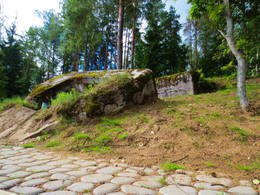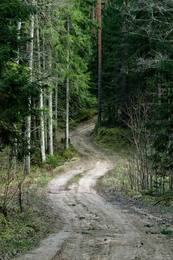Kegumos gyventojų pastangos išgelbėti elektrinę
1941 m. birželio 22 d. (sekmadienį) Latvijoje prasidėjo Antrojo pasaulinio karo įvykiai. Karo banga „praėjo“ per Kegumą be didesnių mūšių. Sovietų armijai skubiai traukiantis, Rusijos kareiviai taip pat puldinėjo Tomės sodybas, kad apsirūpintų maistu.
Siekdami apsaugoti gyventojus, įkūrėme apsaugos grupę su kontaktiniu punktu Tomeso elektrinėje. Į mūsų elektrinę atvyko elektrinės darbuotojas Aldermanis iš „Stuteni“ namo ir technikas su direktoriaus Krasovskio prašymu padėti užkirsti kelią numatomam elektrinės sprogimui.
Rusijos saugumo vadovybė paprašė direktoriaus P. Krasovskio ir asmens, kuris galėtų parodyti jiems lankytinas vietas, elektrinės plano. Tunelyje padėtos dėžės su dinamitu, mums reikia turėti galimybę patekti į vidų ir nupjauti prijungtus laidus. Veikiame greitai ir atsargiai, stebėjimui naudodami Bikių ūkio namo palėpę.
Rusiškomis uniformomis apsirengusiems kareiviams leidžiama kirsti tiltą, tačiau eiliniai sulaikomi, kol patikrinami jų dokumentai.
„Įsigiję“ keturių rusų kareivių uniformas, mūsų elektrinės darbuotojai infiltruojasi į didesnę rusų grupę, kuri ėjo per tiltą.
Technikas, kaip administracijos asmuo su specialų leidimą, galėjo pasikalbėti su tilto sargybiniais. Kaip ir planuota, technikas sutiko mūsų žmones, ir jiems pavyko slapta patekti į šachtą ir nupjauti laidus. Kitą dieną technikas atvyko su pono Krasovskio padėka už atliktą darbą. Mūsų informatoriai perspėjo, kad vadavietėje pastatytas bombų paleidimo įtaisas, kuris rodys laidų pažeidimus. Stebėjome, ar rusų bombonešiai aptiks pažeidimus ir sukels aliarmą. Įvykiai įsibėgėjo. Karines tilto sargybos dalis pakeitė civiliais drabužiais apsirengę policijos sargybiniai (su užrašu ant rankovių). Kilo neramumai, o kai kelyje pasirodė keli vokiečių šarvuočiai, elektrinė liko be sargybos. Techniko siūlymu, savanoriais perėmėme sargybą ir kelias dienas mūsų vyrai saugojo Kegumą. Atvyko ponas Krasovskis su savo štabu, privažiavo vokiečių šarvuotas automobilis, jo vadas trumpai pasikalbėjo su vadovybe ir išėjo.
Iš Rygos atvyko vokiečių politinė vadovybė ir Rygos rajono viršininkas Veida. Jis asmeniškai padėkojo man ir Tomės sargybiniams už mūsų patriotinį darbą. Gavome atlyginimą, pirmuosius vokiškus pinigus Latvijoje ir pašaukimą tarnauti policijoje... Džiaugėmės, kad įvykdėme pono Krasovskio prašymą ir kartu apsaugojome mūsų Ķegumo elektrinę.
Dabar, po dešimtmečių, suprantu to momento pavojų Kegumams ir milžiniškas direktoriaus Krasovskio pastangas iš visų jėgų išgelbėti mūsų elektrinę.
Tačiau birželį, Raudonajai armijai traukiantis, ant 80 metrų ilgio 6-ojo Kegumo tilto tarpatramio buvo numesta bomba, siekiant šiek tiek sutrukdyti Hitlerio armijos žygiavimui į rytus. Elektrinė tęsė savo kasdienį darbą. Tiltas buvo atkurtas į savo medinę konstrukciją per du mėnesius.
Tuomet žalą turėjo sutvarkyti mano prižiūrima statybininkų grupė, pastatydama kopėčias ir tiltą per susprogdintą atkarpą, kad darbai galėtų tęstis. Vėliau buvo pastatytas kabantis tiltas, nes žvyrą betonavimui reikėjo atvežti iš Birzgalės. Šiuo tiltu vienu metu galėjo važiuoti vienas vežimėlis. Darbo buvo daug.
Andersone, R. 2004. Kegumo hidroelektrinė. p. 69.
Susijusi laiko juosta
Susijusios vietos
Vokiečių armijos betoninis ugnies punktas prie Kegumo HE rezervuaro Žegos upės žiotyse
Įsikūręs Kegumo HE rezervuare prie Žegumo upės žiočių (priešais Žegumo namus), kairiajame jos krante. Vienas vizualiai ir vaizdingai įspūdingiausių bei geriausiai išsilaikiusių betoninių gaisrinių, skalaujamų Dauguvos bangų. Jį galima pamatyti iš didesnio atstumo. Nuo kranto iki gaisrinės viršūnės (apaugusios žole) pastatytas pėsčiųjų tiltas. Į gaisrinės betonines sienas įmūryti siaurojo geležinkelio (?) bėgiai. Į jį galima patekti nuo pėsčiųjų tilto. Tai vienas iš Vokietijos armijos Pirmojo pasaulinio karo gynybos linijos ugnies taškų kairiajame Dauguvos krante, kurį galima daugiau ar mažiau atsekti per visą Dauguvos kairįjį krantą. Minėta gynybos linija yra didelio masto karinė sistema, kuri dar nėra iki galo įvertinta kaip vientisas darinys. Gaisrinės liekanas galima apžiūrėti plaukiant valtimi Kegumo HE.
Vokiečių armijos betoninis ugnies punktas viršutiniame Kegumo HE krante priešais Andulį
Jis yra apie 1,2 km į rytus nuo nedidelio upelio, išplatėjusio (upelis įteka į Lejasgrantinius) stataus Kegumo HE kranto šlaito viršuje priešais Andulius. Šioje vietoje krantas apaugęs mišku ir pomiškiu, todėl tik atidus stebėtojas pastebės šį gaisro tašką iš rezervuaro pusės. Gaisro taškas yra gerai išsilaikęs, nes jo nepažeidė kranto erozija. Tai vienas iš Vokietijos armijos Pirmojo pasaulinio karo gynybos linijos ugnies taškų Dauguvos upės kairiajame krante, kurį galima daugiau ar mažiau atsekti per visą Dauguvos upės kairįjį krantą. Minėta gynybos linija yra didelio masto karinė sistema, kuri dar nėra tinkamai įvertinta kaip vientisas darinys. Gaisro tašką galima apžiūrėti plaukiant valtimi Kegumo HE, nes jis yra privačioje teritorijoje.
Vokiečių armijos betoninio ugnies punkto liekanos Kegumo HE rezervuare priešais Sidrabinius
Įsikūręs apie 0,25 km į rytus nuo Kegumo HE rezervuaro įlankos netoli Silapūpēžių, Jaunjelgavos kryptimi, priešais Sidrabinių ūkį. Gaisrinė iš dalies įgrimusi į vandenį ir suskilusi į kelias dalis, primena statybinių atliekų krūvą. Krantas apaugęs. Tai vienas iš Vokietijos armijos Pirmojo pasaulinio karo gynybos linijos ugnies taškų kairiajame Dauguvos krante, kurį galima daugiau ar mažiau atsekti per visą Dauguvos kairiojo kranto ilgį. Minėta gynybinė linija yra didelio masto karinė sistema, kuri dar nėra iki galo įvertinta kaip vientisas darinys. Gaisrinės liekanas galima apžiūrėti plaukiant valtimi palei Kegumo HE. Apie 150 m į vakarus nuo Dauguvos kranto į vandenį įgriuvo dar vieno gaisrinės liekanos.
Vokiečių armijos betoninio ugnies punkto liekanos Kegumo HE rezervuare priešais Jaundaugulius
Įsikūręs Kegumo HE rezervuaro pakrantėje, apie 0,6 km į rytus nuo Žegos žiočių, priešais Jaundaugulius. Gaisrinės punktas nuslinko nuo kranto į vandenį ir suskilo į kelias dalis. Į jį įaugo du didesni beržai, išaugo tankumynas. Viena jo dalis su krantu sujungta pėsčiųjų tiltu. Tai vienas iš Vokietijos armijos Pirmojo pasaulinio karo gynybos linijos ugnies punktų Dauguvos kairiajame krante, kurį galima daugiau ar mažiau atsekti per visą Dauguvos kairiojo kranto ilgį. Minėta gynybos linija yra didelio masto karinė sistema, kuri dar nėra iki galo įvertinta kaip vientisas darinys. Gaisrinės punkto liekanas galima apžiūrėti plaukiant valtimi Kegumo HE.
Vokiečių armijos betoninis ugnies punktas Kegumo HE krante netoli Puduri
Įsikūręs pusiasalyje prie Konupītės upės (dabar užtvindytos upės tęsinio) žiočių Dauguvoje, Puduri poilsio komplekso teritorijoje. Dėl bangų erozijos ugnies punktas pakrypo upės link. Siekiant išvengti krantų erozijos, rezervuaro krantai sutvirtinti betonine apsaugine siena. Vokietijos armijos gynybos linijos ugnies punktus Pirmojo pasaulinio karo metu galima atsekti daugiau ar mažiau per visą Dauguvos kairįjį krantą. Minėta gynybos linija yra didelio masto karinė sistema, kuri dar nėra iki galo įvertinta kaip vientisas darinys. Ugnies punktą galima gerai pamatyti plaukiant laivu Kegumo HE.
Vokiečių armijos betoninio ugnies punkto liekanos Kegumo HE rezervuaro pakrantėje priešais Silapūpėžį
Įsikūręs apie 0,1 km į rytus nuo Kegumo HE rezervuaro įlankos netoli Silapūpēžių, Jaunjelgavos link. Gaisrinė iš dalies įgrimzdo į vandenį, apaugo medžiais, krūmais ir kita augmenija, o nepažįstančiam iš didesnio atstumo nuo vandens pusės jis gali priminti didesnį akmenį. Vienas iš orientyrų – ant jos augantis beržas. Tai vienas iš Vokietijos armijos Pirmojo pasaulinio karo gynybos linijos ugnies taškų Dauguvos kairiajame krante, kurį galima daugiau ar mažiau atsekti per visą Dauguvos kairiojo kranto ilgį. Minėta gynybinė linija yra didelio masto karinė sistema, kuri dar nėra iki galo įvertinta kaip vientisas darinys. Gaisrinės liekanas galima apžiūrėti plaukiant valtimi palei Kegumo HE. Apie 150 m į rytus nuo Dauguvos kranto į vandenį įgrimzdo dar vieno gaisrinės liekanos.
Galima Otomaro Oškalno bunkerio vieta
Atoki ir sunkiai prieinama vieta yra didelis miškų masyvas, esantis apie 200 m į vakarus nuo Žegos upės ir apie 0,5 km į pietvakarius nuo Žegos užliejamos lygumos. Į minėtą vietą rekomenduojama nuvykti pėsčiomis arba dviračiu, naudojantis LIDAR žemėlapiais ir geografinėmis koordinatėmis. Minėtoje vietoje yra maždaug kilometro ilgio (V – R kryptimi) ir pusės kilometro pločio (Š – P kryptimi) natūralus kopų kalnagūbris, apaugęs spygliuočių mišku. Kopų masyvo šiaurinio ir rytinio šlaitų viršutinėse dalyse yra gerai išsilaikę apkasai, spėjama, iš Antrojo pasaulinio karo laikų. Harijs Jaunzems (buvęs Kegumo HE inžinierius) mano, kad šioje vietovėje (konkreti vieta nežinoma) buvo Otomāro Oškalnso suformuoto Raudonosios armijos partizanų būrio bunkeris.
Princo Leopoldo kelias (Prinz – Leopold Straße)
Pirmojo pasaulinio karo vietos (kelio) pavadinimas yra „Prinz – Leopold Straße“ – Kunigaikščio Leopoldo kelias. Istorinis miško kelias arba jo vieta, apie 7 km ilgio, prasidėjo Didžiojo Kurfürsten Damm ir Kaiser Damm sankryžoje prie vadinamojo Kurlando paminklo (Kurland Denkmal) ir vingiuoja per mišką Birzgalės link, susijungdamas su Pirmojo pasaulinio karo siaurojo geležinkelio linija: Lāčplēsis – Latgale. Į vakarus nuo kelio ir apie 2 km į pietus nuo Kurlando paminklo (Kurland Denkmal) yra Pirmojo pasaulinio karo šaudykla. Šiandien Kunigaikščio Leopoldo keliu galima vaikščioti pėsčiomis, važiuoti dviračiu ir automobiliu (tinkamomis sąlygomis). Kelias kerta Konupītę ir Žegos intaką.
Manoma, kad vokiečių armijos kareiviai, ilgą laiką praleidę kairiajame Dauguvos upės krante, šį kelią pavadino Bavarijos princo Leopoldo (1846–1930), kuris Pirmojo pasaulinio karo metu vadovavo Vokietijos ir Austrijos-Vengrijos pajėgoms Rytų fronte, vardu.












